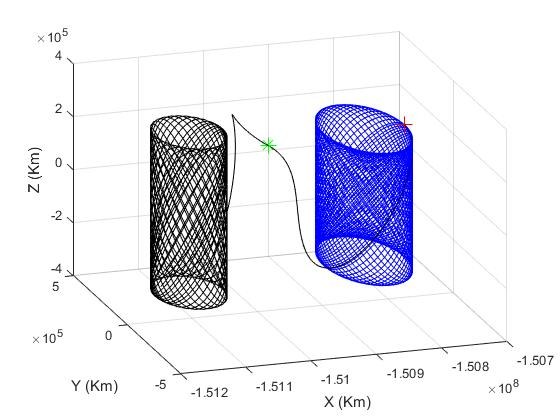New strategies for the control of spacecraft propelled by solar radiation
Jun 15, 2023
The student Xun Duan supervised by professors Josep Masdemont, Gerard Gomez and Xiaokui Yue defends his PhD thesis on the study of the movement of a spaceship equipped with a solar sail around artificially created libration points and orbits.
A solar sail is a method of spacecraft propulsion that uses only the solar radiation pressure (SRP). It has advantages in fuel consumption, high specific impulse, high payload, and consistent small-scale of the thrust, with wide-ranging applications in deep-space exploration missions. The main research object of this thesis is a solar sail spacecraft in the artificially created libration point orbits. It proposes a strategy to accomplish impulsive maneuvers by changing the parameters of the sail. The main new results are the following:
1. Computation of artificial libration points as a function of the parameters of a solar sail (cone angle , clock angle , and lightness number). The SRP is an additional repulsive acceleration in the CR3BP. As a result, the CR3BP equilibrium points L 1 , L 2 …L 5 are shifted from their original positions. The new points SL 1 , SL 2 …SL 5 correspond to positions in the rotating system where the gravitational, centrifugal, and SRP forces are balanced. These points can be represented as functions of the sail parameters , , and . Determination and adjustment of the solar sail parameters, computation of impulse maneuvers and their application to heteroclinic orbit transfers between Lissajous orbits plus a sensitivity analysis of the parameters of the maneuver for orbit transfers. The dynamics of solar sail maneuvers is conceptually different from classical control maneuvers, which rely only on impulsive changes to the velocity of a spacecraft. Solar sail orbits are continuous in both position and velocity in a varying vector field, which opens up the possibility for the existence of heteroclinic connections by changing the vector field with a sail maneuver. Based on a careful analysis of the geometry of the phase space of the linearized equations of motion around the equilibrium points, the key points are the identification of the main dynamic parameters and the representation of the solutions using the action-angle variables. The basic dynamic properties of the connecting families have been identified, presenting systematic new options for mission analysis in the libration point
regime. Based on the proposed method for making impulse maneuvers, this thesis has carried out extensive research:
- (1) By applying a single-impulse maneuver, two spacecraft can reach the same final Lissajous orbit despite starting from different initial phases.
- (2) A transfer strategy is proposed that uses multi-impulse maneuvers. The initial and final solar sail parameters are fixed.
- (3) A spacecraft can use multi-impulse maneuvers to make back-and- forth jumps between the initial and final artificial libration point orbits.
2. Avoidance of forbidden zones considering impulsive maneuvers with the sail. There is a cylinder-like zone around the Sun--Earth axis where solar electromagnetic radiation is especially strong. The L 1 libration point lies on this axis and is between the two bodies. The Earth half-shadow in the L 2 region can also prevent a spacecraft from obtaining solar energy. Both problems can be modeled by placing a forbidden or exclusion zone in the YZ plane (around the libration point), which should not be crossed. To simplify and visualize the avoidance of forbidden zones, this thesis projects the 3D forbidden zones into the so-called effective phase plane (EPP), which has dimension 2.
3. Station-keeping of a solar sail moving along a Lissajous orbit. The designed station-keeping procedure periodically performs a maneuver to prevent the spacecraft to escape from a certain Lissajous orbit. The maneuver is computed so that it cancels out the unstable component of the state. Moreover, it is assumed that there is a random error in the execution of the maneuver. Considering the maneuvers performed every month, we show that the spacecraft can remain near the artificial libration points for at least 5 years, which demonstrates that station-keeping using sail reorientations to produce multiple impulses can be effective.

Share: